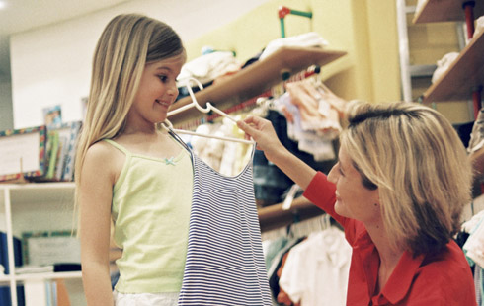How Aussie Retailers Can Better Appeal To Mums
I came across an article from the UK some time ago that now, being a mum resonates quite profoundly. It was titled '12 ways for retailers to appeal to mums' and there are some solid

I came across an article from the UK some time ago that now, being a mum resonates quite profoundly. It was titled ‘12 ways for retailers to appeal to mums‘ and there are some solid lessons in here that all Australian retailers could learn from.
Why are mums important?
Mums have for decades been the most important group of consumers that retailers can reach. They often control much of the household spending, from food to homewares, they purchase clothes for themselves and sometimes male partners, they buy toys and clothing for their children and help shape their offspring’s future shopping habits, and they are often the primary purchaser of big-ticket items such as sofas, fridges and beds. While dads often play this role too – and no doubt face many of the same issues outlined below – mums are often still the primary target for many retailers.
Because mums hold such a large part of the spending power in their hands, what they think matters. To find out exactly what is important to them, we worked with research agency Discovery Research to speak to two groups of mothers – one comprised women with children aged four to eight, and another with children aged 10 to 16.
We found that, while some retailers work hard to tailor their offer to mothers, the shopping experience is still often miserable. Words such as anxiety, dread and stress featured regularly during the focus groups.
The experience also differed between the two groups, although there were some strong links. Below, we list what retailers can do to make sure mums love shopping with them.
Mums with children aged under eight
1. Help reduce stress
Worried, frustrated and broke are some of the words that came to mind for mums of young children when asked to write down how shopping makes them feel.
The experience of shopping with children under eight is not one most relish. Camilla Appiah, who is 39 and has two boys aged six and eight, says supermarket shopping makes her “anxious”. “I don’t like doing supermarket shopping with the boys,” she says. “It takes me ages and I have to get them involved or they get bored.”
Natalie Sexby, who is 27 and has a five-year-old daughter, says the experience “fills me with dread”. She adds: “I just know it’s not going to go well.”
The experience is different, however, if mums are taking their children shopping for clothes or other treats that are specifically for their son or daughter. “I really love shopping for my daughter,” says Joanne Molloy, 30, whose daughter is six years old. “But we’re not so happy if it’s the food shopping. She doesn’t enjoy that and asks for unnecessary bits and pieces.”
Joanne Geere, research director at Discovery Research, says: “There’s a general hesitance and dread that shopping with children brings. They are looking to shops to help them with that. They want to save time, save money and save angst.”
Retailers should look closely at how mums are interacting with their brand and pinpoint ways to reduce the levels of stress they experience. Whether it’s providing ways to keep children occupied, ensuring the aisles are wide enough for pushchairs or making sure everything is clearly labelled and easy to find, there are dozens of opportunities to make the shopping journey less stressful.

2. Keep children entertained
Our group of mums said children tended to be happy if the shopping mission was centred around their needs or interests – in children’s clothes departments or toy shops, for instance – but there is a clear need for help in engaging children when the shopping trip isn’t focused directly on them. This could mean either helping to involve children in the shopping process itself, or providing them with something that will keep them occupied while the shopping gets done.
Camilla says: “If you can do things they’re involved in, it’s fun. But I can’t imagine them being in Westfield for a day.”
Sometimes she and her husband do shifts when the family is out shopping together – he’ll look after the children for an hour while she buys something she needs and vice versa.
Nicola Reid, 38, says that some shops have particularly helpful staff who will step in and engage children for a couple of minutes while she looks at something. She says a sales assistant at cosmetics retailer Lush distracted her son, who is four, while she browsed.
Mums suggested providing small trolleys for children to push around supermarkets, which helps them feel part of the job and makes the trip more fun. Some parents also use supermarket shopping to teach children about money, simple maths and budgeting.
Nicola says: “I think it’s good for children to see you go to a supermarket so they learn about budgets and so they don’t think a fridge has magically appeared with food in it.”
Joanne says her daughter loves using the self-scanning machines and paying for items herself. “It gives her a sense of independence,” she says.
Retailers could also provide simple activities for children to take part in as they go around the store with their parents. The mums in our groups highlighted the helpfulness of Asda’s recent Halloween mobile game – games on smartphones can be a good way of distracting children.
Crèches, however, aren’t a popular idea. Most mums are too affected by scare stories of missing children to be comfortable leaving theirs in a supermarket crèche.
3. Alleviate guilt
“Sometimes I’ll buy something for myself and feel guilty,” Joanne says. “Before children, it didn’t matter if at the end of the month you are eating beans on toast. But when you have children you can’t think like that.”
Natalie agrees children have to come first, and Camilla adds: “I think, if I buy this for myself that’s money that would pay for my kids’ swimming lessons. You think about things a lot more and how you spend your money.”
There is an opportunity for retailers to step in and help alleviate this guilt mums feel, either through their marketing messaging or by providing ways for mums to treat themselves and their children at the same time or in an inexpensive way.
4. Improve facilities
While supermarkets scored highly with mums in many ways because of their wide aisles, low prices and breadth of choice, their facilities are not always up to scratch.
The focus group members were unanimous in wanting cleaner toilets and baby-changing facilities, as well as areas for breastfeeding.
Stephanie Jennings, 26, says: “A lot more parent and child parking would be helpful. It would also be nice to have mini toilets for children, and sinks that are lower down – I have to hold my son up to wash his hands.”
Other popular ideas included trolleys that had a shelf underneath the main compartment to hold a buggy, and lockers in shopping centres or department stores so shopping bags could be stored.
5. Help them plan their week
Most mums in the group used to have a more flexible approach to money and shopping, but Natalie says she plans her weekly food shops now. “I plan the whole week so I know what I’ve got to spend,” she explains.
Most say they used to shop more with smaller, local shops but now use large supermarkets where everything can be purchased at once. Apps or other online services that help shoppers plan and budget could benefit busy mums.
Geere says: “They want to feel like they’re shopping smart, and want to feel as though they’re doing efficient shopping.”

6. Don’t alienate them
Lots of mums with young children are still young themselves, but being a mother means they often feel unwelcome in or alienated by shops that are supposed to be designed to appeal to women their age.
Stephanie says: “I used to go to Topshop all the time but I wouldn’t dream of going in there now. I’m only 26 so I like it, but there’s nothing to do with kids in there. As soon as you have kids these doors shut. It’s the atmosphere.”
She adds that, while retailers such as Topshop appeal to her, the shopping experience can be intimidating. “That shop would be all about you as a woman looking good, but it’s not about you as a mum. It’s about fashion. It doesn’t incorporate anything about motherhood.” She now goes to etailers such as Asos to buy clothes.
Other mums spoke of making a snap judgment on whether a store was welcoming to them – if aisles are narrow, products are crammed in or if the messaging is aimed squarely at young women they will avoid it.
Mums with children aged over eight
7. Find new ways of generating loyalty
Falling consumer loyalty is a trend across the industry, and the mums in our focus groups were no exception. Tara Bell, 43, who has a 16 year old, 18 year old and a 22 year old, says: “I have no loyalty. If I can get it cheaper elsewhere I’ll buy it from there.”
Penny Honess, 51, who has a 14 year old daughter, adds: “The way the economy is at the moment, you want the best price. I go where the offers are.”
Mums with younger children agree on this one. Camilla says: “I have got no loyalty. [I’ll shop somewhere] if they’ve got £10 off or free online delivery. I tend to buy things that are on offer.” Several of the participants use loyalty cards such as Nectar, but the retailers that seem to generate the most loyalty are those that give the impression of everyday low value. Shoppers seem keener on finding the lowest prices than collecting points. Asda cropped up once or twice as a popular choice.
Claire Kennedy, 45, has a 10 year old and a 14 year old and says of Asda: “It’s half convenience and half that I’m always impressed with their prices. At Asda you don’t get loyalty points but I know I’m going to get the guaranteed best prices.”
8. Be aware of body image
For mothers of teenage girls in particular, forward thinking retailers are well advised to bear body image in mind and remember that not every 16 year old is a size eight.
Penny says it’s a topic that is pertinent for her daughter and her friends. “Some of these shops don’t even stock larger sizes. The clothes are so tiny,” she says. There are plenty of retailers catering for a fashion-mad size-six teenager, but there is a clear opportunity for young fashion retailers interested in presenting a more varied image of themselves and their clothes.
The group agreed that senior school is where peer pressure hits. Penny says: “Before high school, I could shop anywhere – she wouldn’t care. Now it’s all ‘I’m not wearing that’.” Claire says: “It’s now harder to keep to a budget.”
9. Remember these are savvy shoppers
Mums of teenagers – and teenagers themselves – are well aware of what offers and promotions are available to them and are keen to share their savings with friends. By comparison, few would be keen to shout about wealth.
Angela Garvin, who is 45 and mum to a 12 year old, says: “I wouldn’t flaunt having lots of money, but I do share bargains. Times have changed – in the 1980s, people loved to say how much things cost.” Claire believes: “Mothers and women today are certainly savvier shoppers than ever.”
This is as true for many of the teens themselves as it is for their mothers. Penny says of her daughter: “She likes promotions. If she knows she can get a better deal for 20% off there’s more chance I’ll say she can have it.” Not only are mums awake to what offers are available, but they are clued up on some aspects of how marketing, advertising and price margins work.
Tara talks about the strength of the power of advertising on her children, and Penny says she tries hard to make it clear that the retail price of some expensive brands does not reflect their real cost. “It might be £70 for that hoodie but the mark-up is colossal and it doesn’t cost that much to make. She’s slowly coming around,” she says.
10. Cater for teens
Mums are well aware of marketing deals for university students. Whether it’s 10% off, discount cards or events aimed at the student population, retailers are well versed in targeting young shoppers away from home for the first time. While this makes perfect sense, the mums in our focus groups want more of the same for younger teenagers, who are often just as aware of brands as their elder counterparts.
Rubini Subramaniam, 32, whose daughter is 14, says: “I’d like to see 10% off for teenagers or similar offers. Retailers can miss teenagers.”
Tara adds: “It’s a difficult age for a retailer to engage with. Toddlers and younger children are easier – retailers cater for that age but then tend to lose them as teenagers.” Claire observes: “We all lose them. They really are their own species.”
11. Remember that value for money is important to mums
It’s no secret that mums of teenagers spend a good deal of time and energy trying to stop them wanting so much and teaching them the value of money. This clearly goes against retailers’ raison d’être – to make people buy more -but businesses could do well to remember the types of challenges mothers face if they want to be thought of fondly.
As Angela says: “I’m trying to get him to eat healthily. He just wants a new pair of trainers.” Ella Hudson, 51 and mum of a 16 year old, says she has to “stand there like a personal shopping assistant” when they go shopping.
Penny says: “Clothes shopping is an absolute nightmare with my daughter. She has got very specific, expensive tastes and it all kicks off when I say she can only have one thing.”
Rubini notes: “It’s more expensive as they get older because they want branded stuff.” Tara says she limits the type of stores she goes into with her children. “I don’t want them to see things they can’t have. I don’t want to go into shops where you can’t afford things. In the last few years we’ve done a lot of work to educate our children on the cost of things.”
Claire adds: “I try to discourage my daughter buying anything gimmicky that won’t be used after a day. I’m trying to instil that and I think she’s picking that up. I don’t want to waste money.”
12. Technology is important, but it’s not everything
Retailers could be forgiven for thinking that technology is everything for shoppers today – the level of hype surrounding technologically driven step-changes over the past five years has been unprecedented. But, while none of the mums in our focus groups were anti-technology, it’s clear this is not the generation for whom technology is non-negotiable.
One area where most are experts is looking for offers, deals and promotional codes online. They are experienced users of sites such as Vouchercodes.co.uk and some devote a significant amount of time to hunting for deals on different sites. They also share these finds with friends on social networks.
It’s a bit more of a mixed picture when it comes to online shopping, however. Some shop for groceries online, especially for bulky items, but many have been put off because of the high number of product substitutions they’ve received, and because pickers often choose foods such as meat that are close to the sell by date. Shoppers themselves will carefully select products that give them a few extra days. Geere says: “For some people it was more hassle than it was worth.”
Shopping for clothes online is popular, however, because mums rarely have the time to browse or shop for fashion in store. Tara says: “I impulse buy a lot online as I can return it. Some stores will only let you have a credit note, but online you can always return things.”
There is a similarly mixed response to mobile technology. Some are avid fans – Tara uses price comparison barcode scanning apps and got £100 off the price of her washing machine as a result – but others are not as aware of the technology.
That doesn’t mean, of course, that retailers should wash their hands of digitally enhanced shopping journeys. It is the teenagers these mums are raising who will be the first generation of digital native shoppers.
While retailers have worked hard on targeting mothers, there are still clearly plenty of opportunities. Children will always make the shopping process difficult – it is up to retailers to focus on how they can alleviate that within their own shopping journeys.
Rebecca Thomson
 English
English










